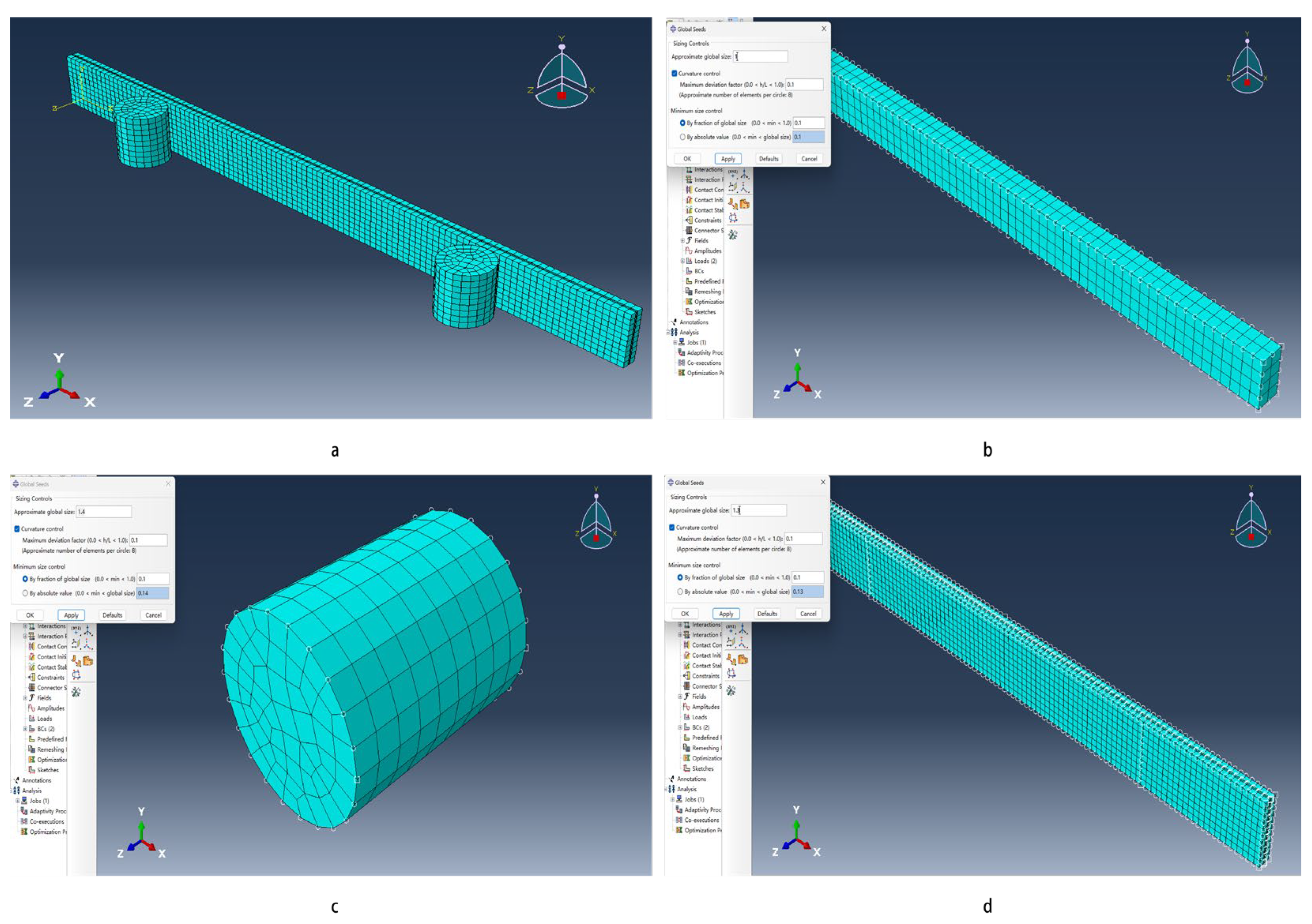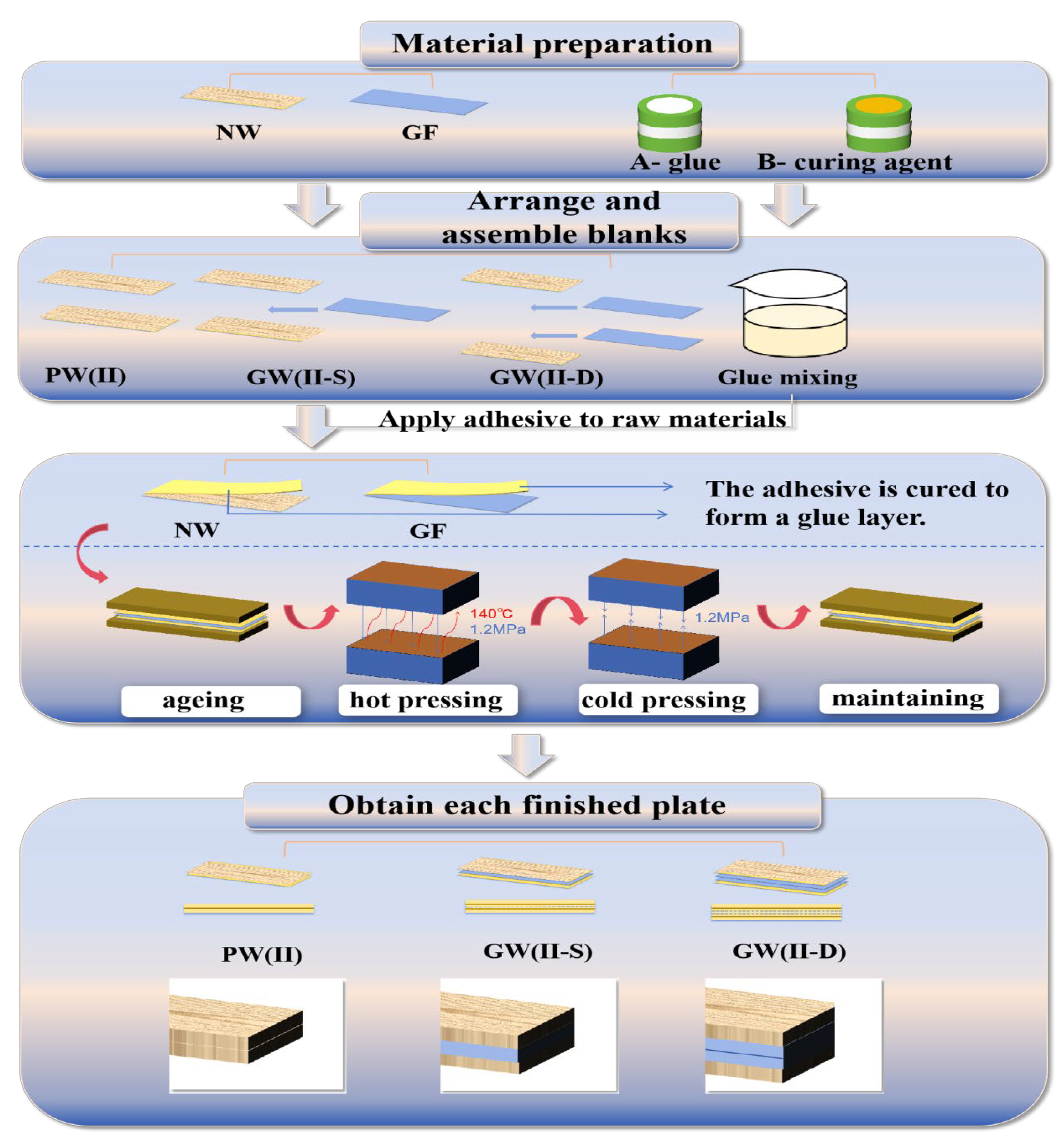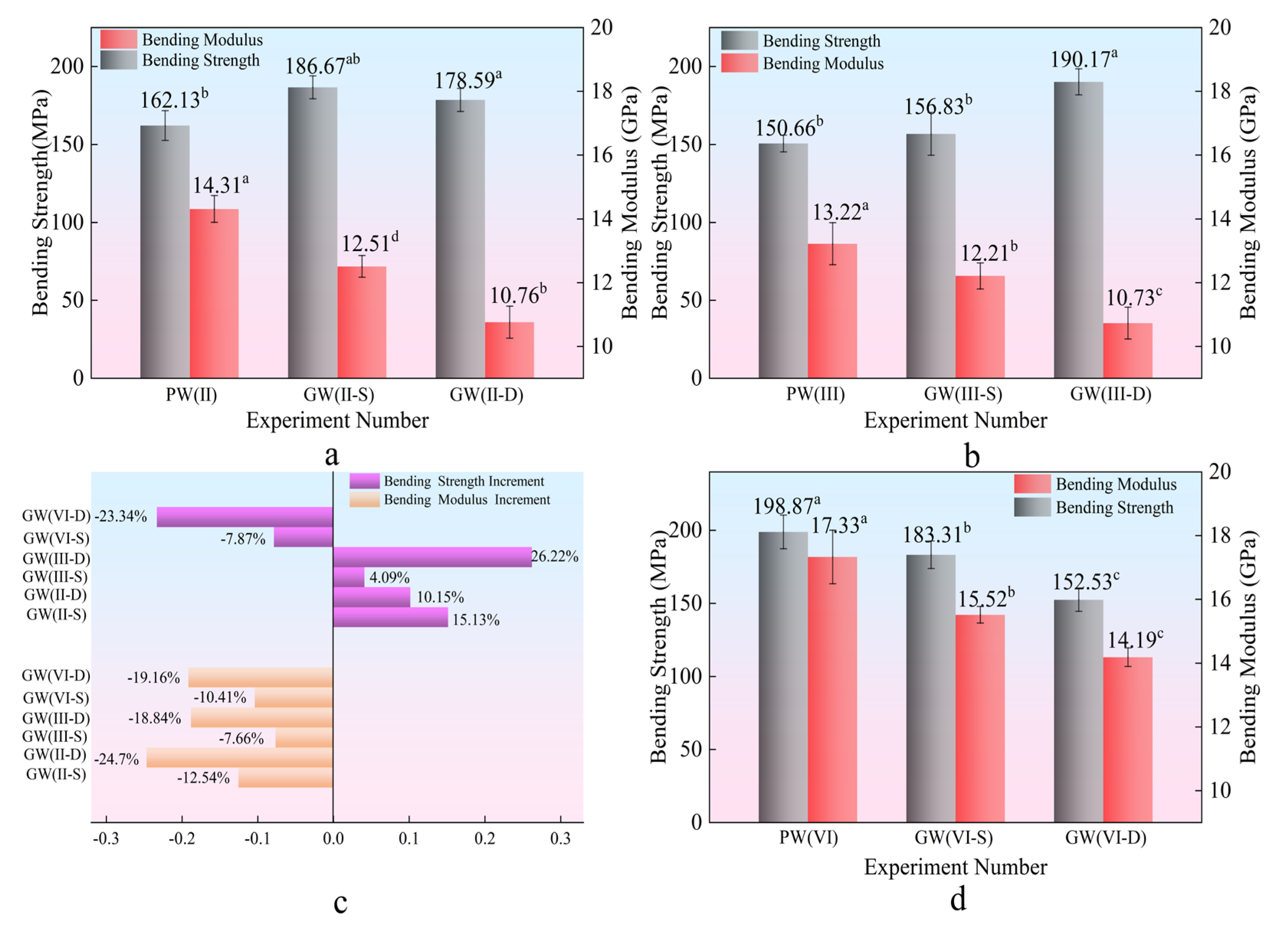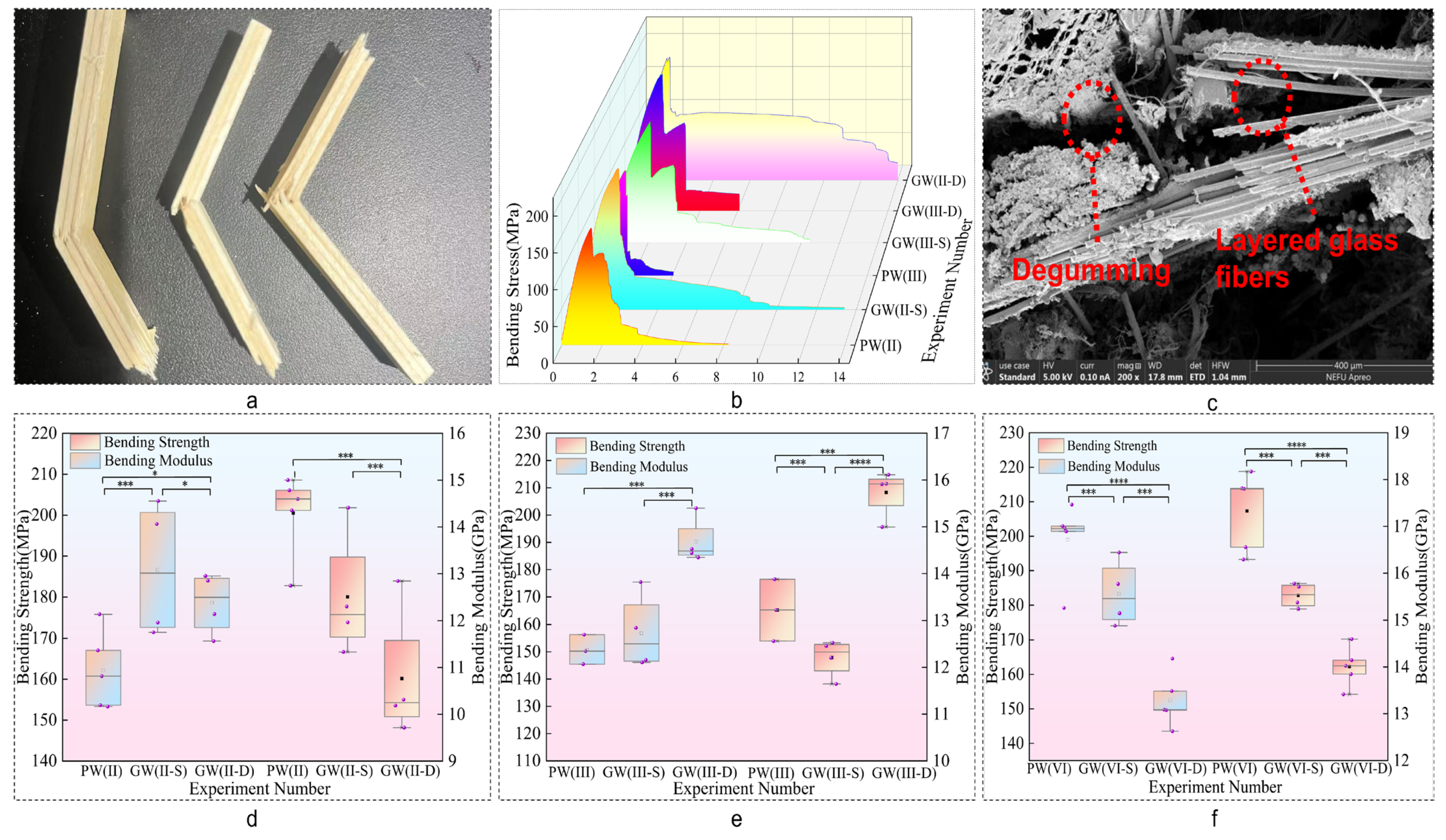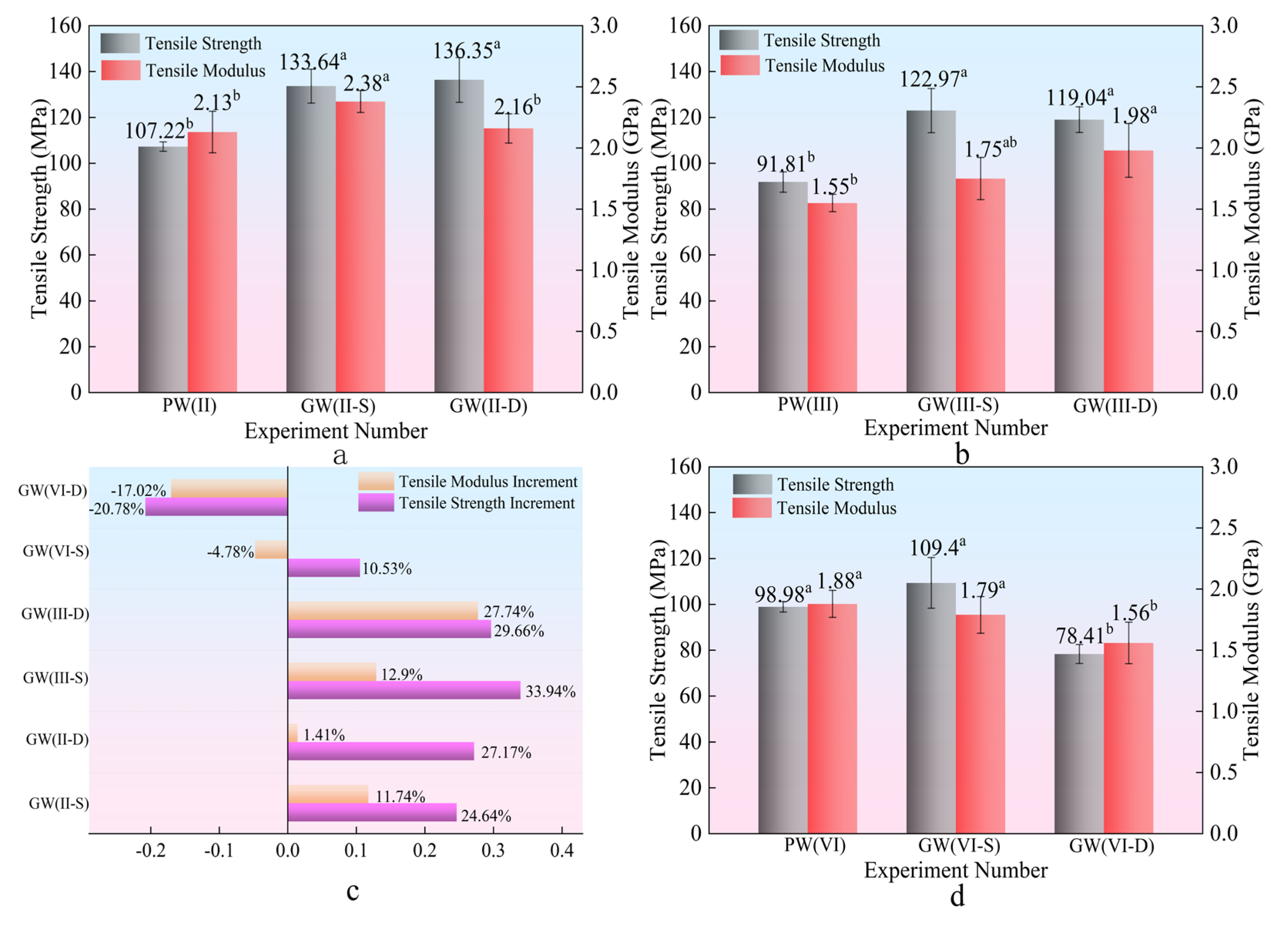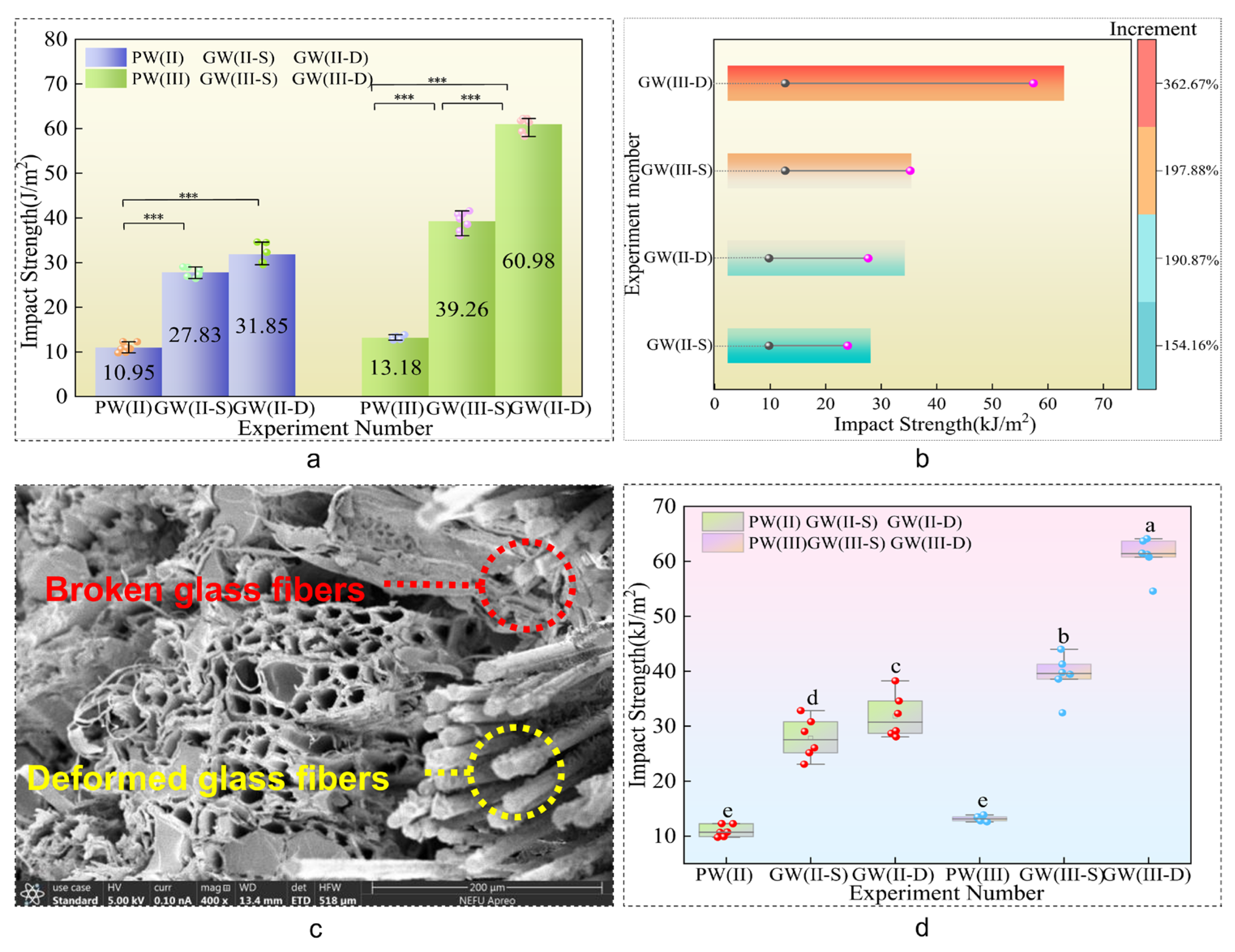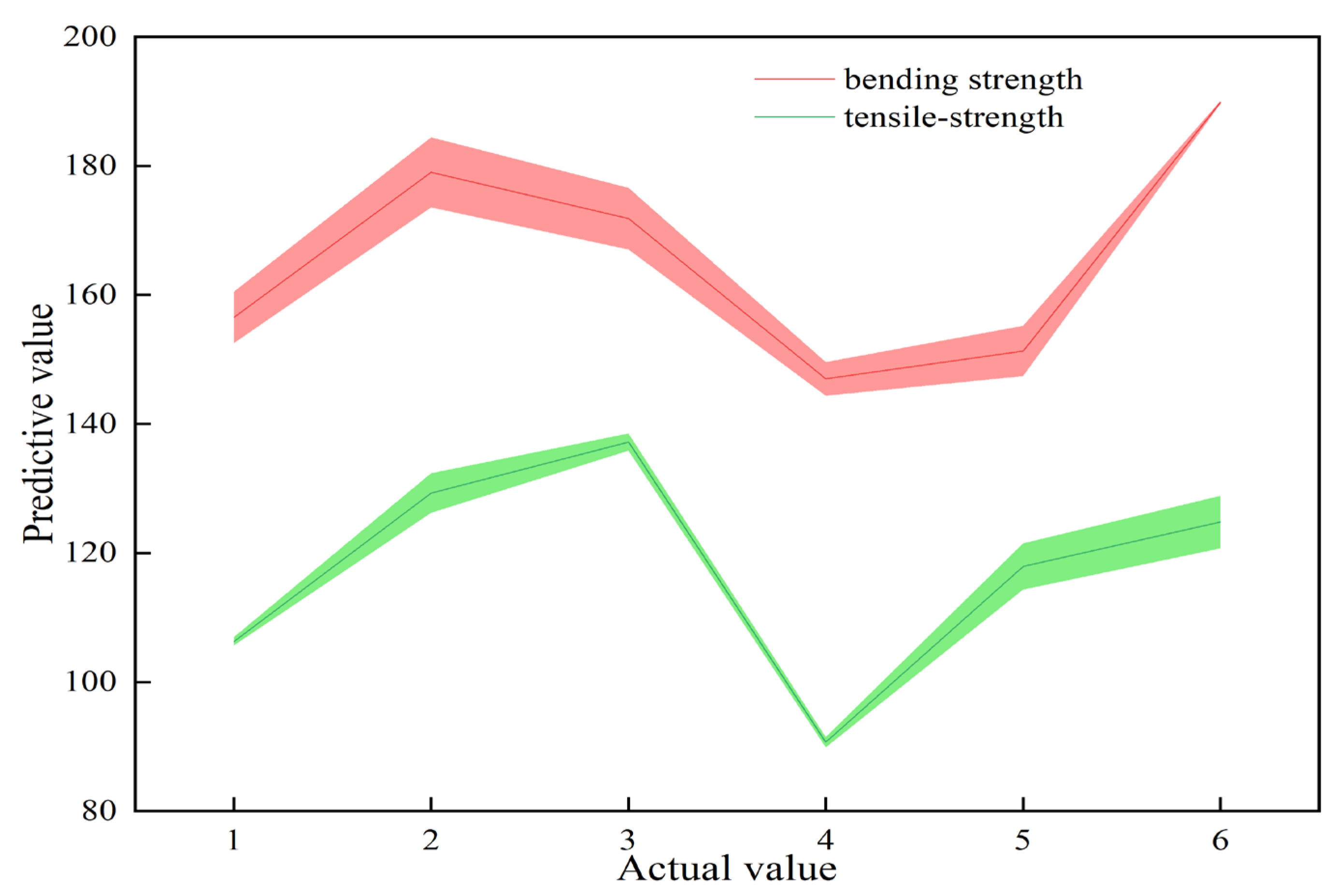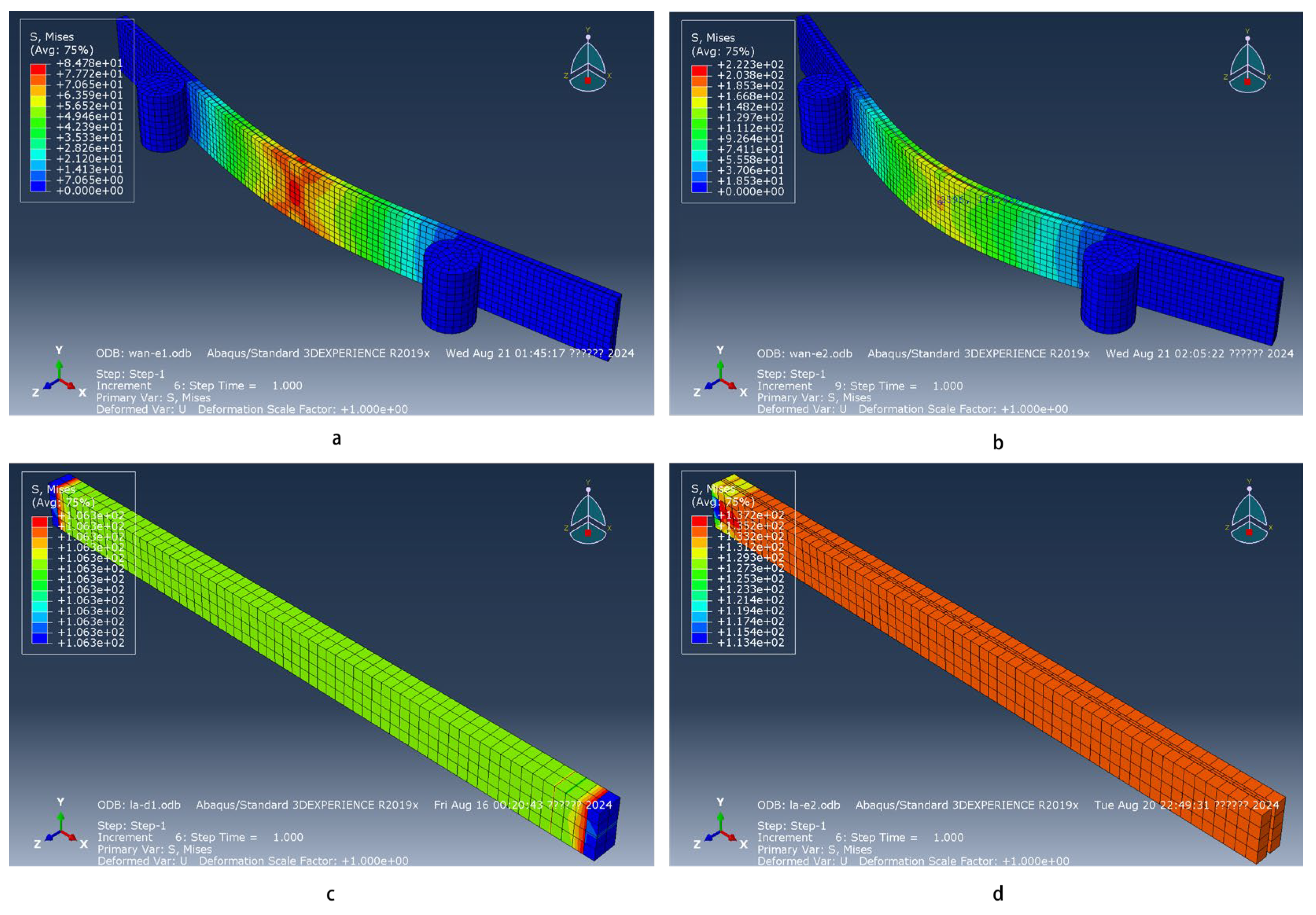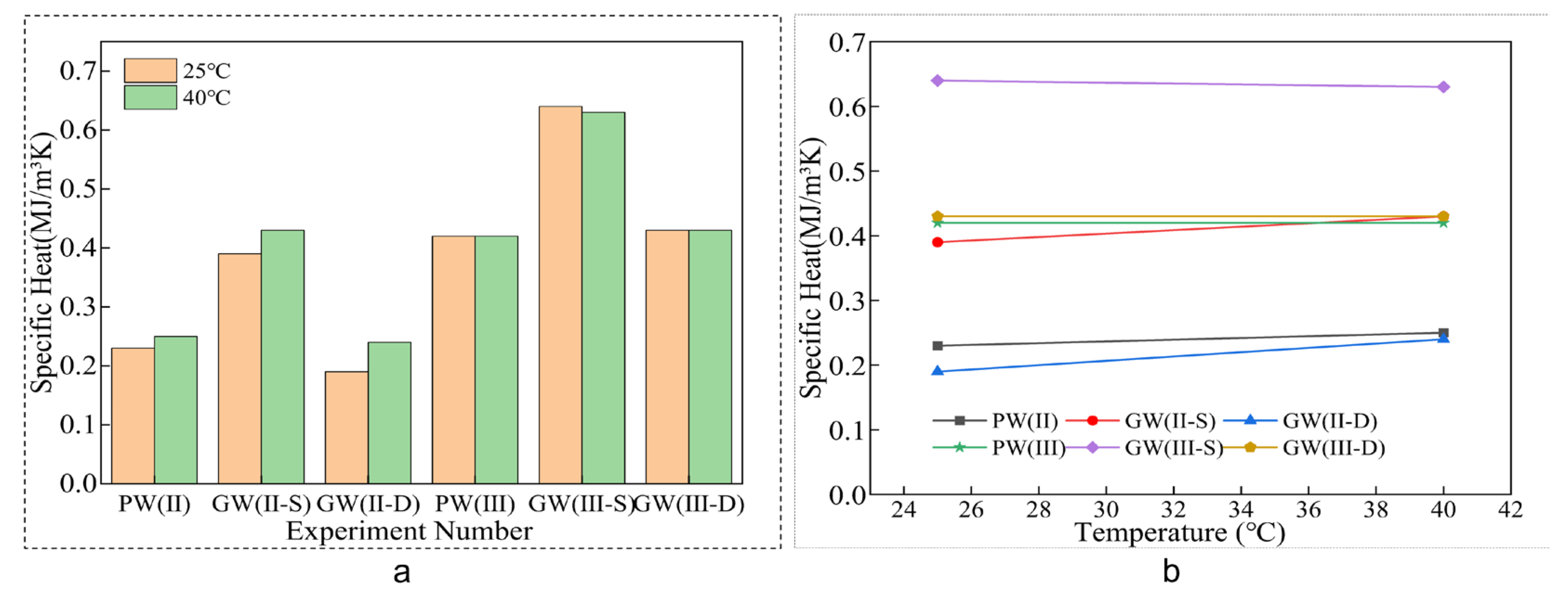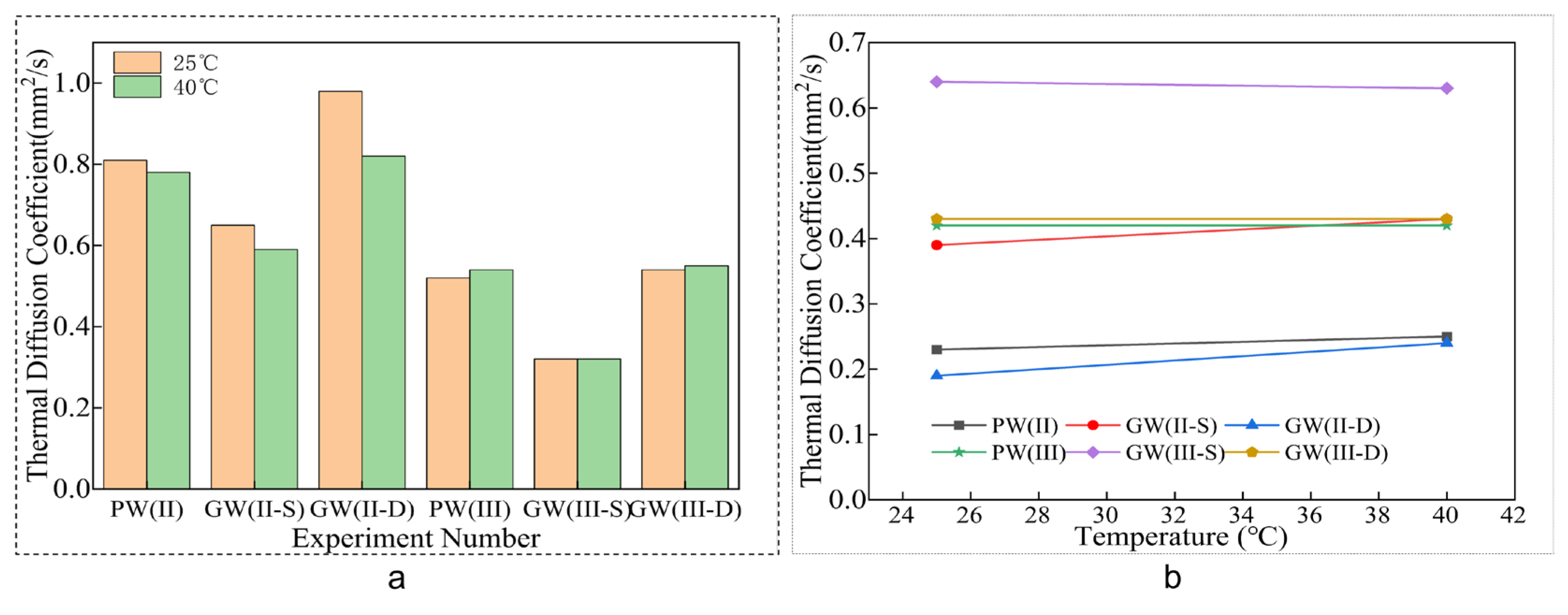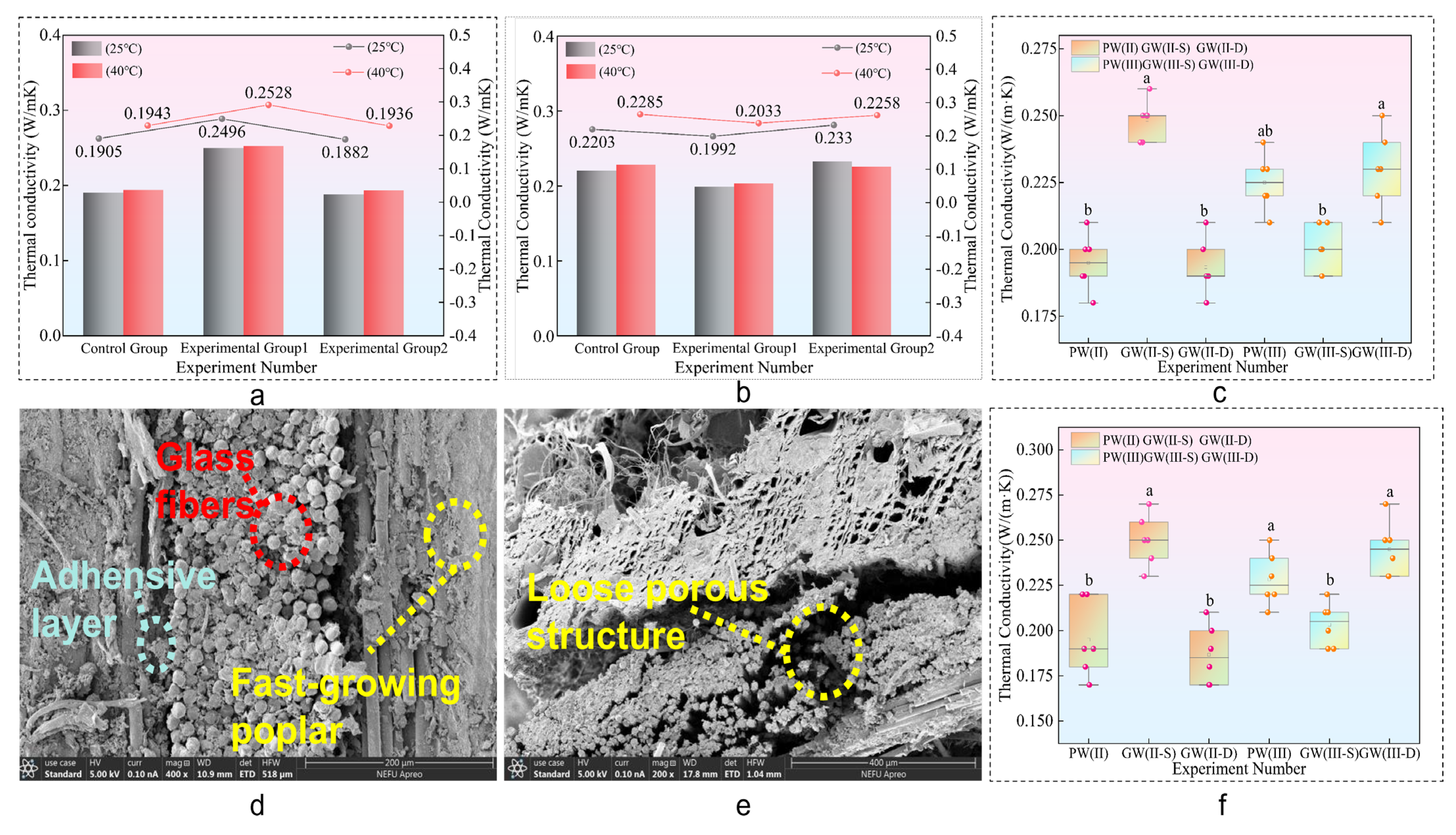1. Introduction
In recent years, there has been a gradual shortage of large-diameter wood raw materials. Various types of artificial wood composite panels have been used extensively in the fields of machinery and building materials, such as beams, columns, wall panels, floors, and other building structures. These panels provide stable support and structural protection for buildings. Wood, the most abundant renewable energy source on Earth, has been extensively utilized in architectural and furniture design throughout history [
1]. This is due to its distinctive aesthetic qualities, environmental sustainability, and ease of use [
2]. However, the anisotropy, porosity, and low density of wood limit its comparison with high-strength materials. Consequently, there is an urgent need to develop sustainable, high-strength, and excellent thermal insulation wood composite materials.
As demonstrated in extant research, the modification of wood composite materials has hitherto been primarily oriented towards enhancing their mechanical and thermal insulation properties. In terms of mechanical properties, researchers like Furuta et al. [
3] have explored methods such as double-sided veneer pasting to enhance the mechanical properties of the plate, while Bekhta’s team [
4,
5] has introduced supplemented nanocellulose to improve the elastic modulus and bending strength of artificial boards. In addition, the mechanical properties of artificial boards can also be enhanced by changing the engraving density [
6], improving interface compatibility [
7,
8,
9], and incorporating materials like non-woven fabric [
10], glass fiber [
11], carbon fiber [
12,
13,
14], and graphite nanosheets (xGnP) [
15]. In the realm of thermal insulation performance, studies have highlighted that the impact of adhesive type and dosage [
16], the thickness of the plate [
17], and the density of plywood [
18] are all closely related to the thermal insulation performance of plywood. Chang et al. [
19] made cross–layered wood to improve the thermal insulation performance of the plate; Jeon et al. [
20] used biochar to enhance the thermal insulation performance of wood; and Chen and his team [
21] made multi–functional biomass aerogels with wood waste as raw material to improve the thermal insulation performance. As an example, Zhang’s team [
22] has used SiO
2 aerogel nanoparticles and C
2H
6O to prepare artificial boards with good thermal insulation performance.
In recent years, research on laminated composite materials has gradually received attention, and mechanical properties are an important criterion for measuring the quality of laminated composite materials [
23,
24]. As demonstrated in extant research, laminated composite materials have been extensively utilized in a variety of fields, including aerospace, transportation, construction, and others. The two main matrix phases of composite materials are wood and metal, and the lamination of these with different reinforcement materials can significantly improve the performance of the composite materials [
25]. Research on improving the mechanical strength of laminated composite materials shows that laminated composite materials made of linear elastic layers exhibit nonlinear "overall" material properties when subjected to nonlinear deformation [
26]. Under nonlinear deformation, the local stress in the layer may not be proportional to the elastic constant of the layer.
Moreover, the lamination of wood veneers with reinforcement materials is a prevalent modification technique. This method is intended to enhance the mechanical properties of wood by eradicating its loose and porous structure and by leveraging the high performance of the reinforcement materials [
27]. Glass fiber, a common and effective reinforcement material, has been widely utilized in furniture [
7] and various industries. Combining glass fiber with poplar veneer has demonstrated notable improvements in the mechanical strength and thermal insulation of artificial boards due to its simplicity, cost-effectiveness, and accessibility. In the extant literature, the Tungjitpornkull team [
28] conducted research on the enhancement of mechanical properties by studying fiber types and fiber orientation angles. Qi, YJ’s team [
29] demonstrated the strengthening effect of glass fibers on wood composite materials by conducting calculations on various tree species and internal stresses. In the laminated modification process of wooden boards, the control of the hot pressing process and the selection of adhesive types and amounts are of great significance. Research has demonstrated that the optimal temperature for hot pressing wooden composite boards is 180 °C [
30], as this results in the most optimal mechanical properties. However, it should be noted that the polarity of the surface of the wood and glass fiber is in opposition, which can have a detrimental effect on the bonding performance of the two materials, thus leading to the delamination of the board. Epoxy resin adhesive has been demonstrated to effectively overcome the disadvantage of incompatibility and provide good bonding performance. It is evident that current research has fully demonstrated that glass fiber, as a reinforcing material, can significantly enhance the mechanical properties of wood composite materials. Existing research on hot pressing conditions and adhesive dosage control is both extensive and comprehensive. However, there is still a lack of systematic exploration and verification on the influence of composite plate thickness, number of layers, and interlayer structure on material properties. At the same time, existing research focuses on enhancing the mechanical properties of laminated composite materials, and there is a lack of research on thermal properties, which needs further exploration and verification.
The aim of this study is to manufacture composite panels using poplar veneer coated with glass fiber cloth, and to obtain test samples for evaluating mechanical and thermal insulation performance by hot pressing components along the fiber direction. By conducting comparative experiments on wood glass fiber composite materials with different interlayer structures, the influence of interlayer structure ratios on the mechanical and thermal properties of the composite materials can be further explored. Using Abaqus 2019 for finite element experimental simulation will comprehensively analyze the stress distribution of glass fiber composite material sheets under different loads, and ultimately determine the optimal interlayer structure of glass fiber-reinforced veneer composite materials.
3. Results and Discussion
3.1. Mechanical Properties of Composite Materials
3.1.1. Analysis of Bending Performance
The Duncan model is used to differentiate the experimental data. There exists a significant difference between groups (
p < 0.05, same below), as summarized in
Table 2.
Figure 4 demonstrates the substantial improvement in plate bending strength, enhanced by 26.22%. Notably, the double-layer glass fiber structure outperforms the single-layer configuration in enhancing strength. The bending strength of the composite plate increases with the number of glass fiber cloth layers, indicating a direct correlation between the number of glass fiber layers and the mechanical strength of the composite. However, the bending modulus decreases by 24.70%, suggesting a reduction in the composite plate’s resistance to deformation [
39]. This trade–off implies that while glass fibers improve load-bearing capacity, they may compromise the plate’s stiffness.
According to
Figure 5b, the bending load-bearing capacity of the experimental group incorporating glass fibers significantly increases. This enhancement is attributed to the fact that glass fibers may diminish the interlaminar properties of the laminate, leading to a propensity for stratification during the compression process. This stratification disperses stress, prolonging load-bearing duration, but also reduces bending stiffness, making the laminate prone to localized yielding and diminishing the bending modulus [
40].
The phenomenon of an increased bending strength and decreased modulus of the test samples is mainly due to the high toughness of glass fiber, which causes a large strain when subjected to bending load. This leads to the delamination fracture of poplar veneer first, while glass fiber still maintains a certain bending strength. The stress–strain curve shows a quadratic upward trend, and the modulus decreases. The interlayer structure of double-layer glass fiber allows for greater strain changes, more significant delamination fracture effects, and a further decrease in the bending modulus of the material.
Figure 5d–f illustrate a 23.34% reduction in bending strength for the PW(VI) group compared to its experimental counterpart, with a notable standard deviation indicating unstable test results. As shown in
Figure 5c, the low interfacial compatibility between composite materials contributes to this variability. As the thickness of the plate increases, interfacial adhesion decreases, hindering effective bonding [
41]. Excessive plate thickness, under identical pressure, temperature, and time conditions, weakens interlayer bonding, leading to relative slippage and decreased performance.
3.1.2. Tensile Strength Analysis
In the tensile stress experiment, as shown in
Figure 6a, the group incorporating glass fibers exhibited a phased damage response. Initially, there was a weakening of strength followed by an increase in stress, culminating in subsequent damage. This behavior stems from the distinct tensile properties of glass fibers and poplar veneer, coupled with the propensity for debonding between the two materials. The compromised interfacial adhesion allows sliding between layers, resulting in a fiber pull-out phenomena [
42]. Consequently, instead of complete destruction, continuous loading induces secondary damage within the composite structure.
The analysis in
Figure 6b–d and
Table 3 indicates a significant enhancement in the tensile strength (33.94%) and tensile elastic modulus (27.74%) of the composite plate. This enhancement implies that the composite plate, with incorporated glass fibers, can withstand higher maximum stress and exhibits improved stability under tensile stress conditions. Within the interlayer structure, an increase in the number of glass fiber cloth layers results in a relatively consistent rise in tensile strength together with a significant improvement in elastic modulus. This highlights the reinforcing effect of glass fibers on the mechanical properties of the composite material [
39].
As depicted in
Figure 7, a decremental trend in tensile strength and modulus is observed for the GW(VI) group compared to its experimental counterpart, with a reduction of 20.78%. This decline is attributed to the inherent strength enhancement of the plate with increasing thickness, coupled with a concurrent decline in bonding efficacy—a similar analysis applies to bending. Consequently, the role of glass fiber in augmenting plate performance diminishes with thickness increase, impacting their reinforcing effect. The composite plate’s tensile strength has notably improved by 33.94%, along with a significant enhancement of 27.74% in the tensile elastic modulus, highlighting increased stress resistance and stability under loading conditions when glass fibers are integrated.
Glass fiber has extremely high tensile strength along the fiber direction, which can significantly enhance the tensile properties of laminated composite materials. In addition, due to the uniform stress distribution of glass fibers under tensile stress, the double-layer glass fiber structure has stress evenly distributed on each layer of fibers [
13]. Compared with the single-layer structure, its tensile strength and modulus do not have a superposition effect. Therefore, as shown in
Figure 7, there is no significant difference in tensile strength and modulus between the two experimental groups.
3.1.3. Impact Strength Analysis
In the domain of impact testing, the data extracted from
Table 4 and
Figure 8a,b,d demonstrate substantial increases in impact resistance within the experimental groups compared to their control counterparts. Notably, the PW(II) group exhibited enhancements of 154.16% and 190.87%, respectively, while the PW(III) group experienced even more significant boosts, with increments of 197.88% and 362.67%, respectively. These findings underscore the notable impact of integrating glass fibers on enhancing the impact strength of wooden plates. The addition of glass fibers is a critical factor in significantly bolstering the impact resistance of sheet metal, thereby improving the structural integrity and durability of the composite material under dynamic loading conditions. Furthermore, the overall impact strength escalates markedly with increasing plate thickness and the quantity of incorporated glass fibers. This enhancement in impact resistance is attributed to the synergistic effect of augmented material thickness and glass fiber reinforcement, leading to a more robust resistance to impact forces.
The incorporation of glass fiber into the composite material, as depicted in
Figure 8c, induces stratification in the interlayer structure. Upon impact, this stratification leads to localized fiber fractures, significant deformations, and a shift in the plate’s damage mode [
43]. This modification allows the material to minimize the affected area and better absorb sudden impact loads. The increased plastic deformation work and fracture work play a role in reducing damage to the laminate, enhancing its ability to withstand external impact loads [
40].
3.2. Numerical Simulation and Stress Distribution
To assess the accuracy of the experimental data, an error analysis was conducted for each experimental group. As delineated in
Table 5, the discrepancies between the experimental data and the finite element simulation results were found to be within a 5% threshold. This alignment between the actual experimental outcomes and the simulation predictions substantiates the authenticity and rationality of the data, affirming the reliability of the experimental procedures and the simulation model employed.
The mean variance loss function was used to calculate the total error of the finite element model, as shown in Equation (9).
Calculations using Equation (9) revealed mean variance loss function values of 30.035 for bending strength and 13.902 for tensile strength, indicating the model’s strong predictive simulation performance.
By using the horizontal coordinates as the actual value, vertical coordinates as the predicted values, and y = x as the reference function, an error band diagram was generated to visually represent the model’s prediction fit and error magnitude, as depicted in
Figure 9.
In conclusion, the experimental outcomes align closely with the predictive results, suggesting a high degree of credibility and precision in the predictive methodology. This approach can be deemed a rational and effective method for forecasting the mechanical properties of materials with a minimal loss of accuracy.
The stress distribution diagram of the test sample under bending and tensile loads is displayed in
Figure 10.
In the context of the three-point bending experiment, an analysis of the stress distribution characteristics of the glass fiber–poplar composite plate has been conducted. Specifically, for the lower surface of the composite plate in the fiber direction, a negative correlation between stress magnitude and distance from the neutral axis is observed. Stress increases more rapidly as one moves closer to the neutral axis. An anomalous stress distribution is noted within the small edge region perpendicular to the fiber direction, attributed to localized stress concentrations common in composite materials under bending loads. The stress distribution perpendicular to the fiber direction manifests three distinct patterns, highlighting the anisotropic nature of stress distribution in composites. These findings underscore the complexity of stress distribution in composite materials and the importance of understanding these patterns for the design and analysis of structural components [
44]. In the region distal to the neutral axis along the fiber direction, stress magnitude remains essentially constant. Proximal to the neutral axis, stress magnitude exhibits a pronounced variation, adhering to a strong–weak–strong distribution pattern. This pattern is indicative of the stress concentration effects near the neutral axis, where the highest stresses are experienced. Conversely, the stress distribution near the neutral axis follows an inverse weak–strong–weak pattern, signifying a transition from a high-stress concentration to lower-stress regions across the composite material’s cross-section. These observations are crucial for understanding the mechanical behavior of composite materials under bending loads and for the accurate prediction of their structural response [
45]. In the same three-point bending experiment context, stress distribution characteristics on the upper surface of the composite plate exhibit a more uniform pattern compared to the lower surface. Along the fiber direction, the magnitude of stress decreases inversely with distance from the neutral axis, intensifying as the distance decreases. Perpendicular to the fiber direction, stress magnitude remains relatively constant. Under conditions of intimate bonding, stress within the glass fiber layer in both experimental groups is generally higher than within the poplar veneer layer, aligning with the stress distribution of the poplar veneer layer [
46].
During the tensile testing, stress distribution across the upper and lower surfaces of the poplar veneer layer appears relatively uniform, indicating even load distribution across each segment [
47]. The stress distribution pattern within the glass fiber layer mirrors that of the poplar veneer layer. However, non-uniform stress distribution is observed along the fiber direction at the composite board’s ends, arising from the need to clamp the board ends during displacement application—a procedural aspect to consider when evaluating stress distribution patterns.
3.3. Analysis of Thermal Insulation Performance
The optimal structures for the main mechanical property tests, PW(II) and PW(III), and their corresponding experimental groups have been analyzed, while the PW(VI) plate with excessive thickness, not suitable for thermal conductivity tests, has been excluded from consideration.
As per the data illustrated in
Figure 11, the specific heat of the glass fiber composite plate remains constant at both 25 °C and 40 °C. An examination of
Table 6 reveals that the single-layer glass fiber cloth configuration exhibits superior thermal properties, with a significant enhancement of 69.57% and 52.38% with specific heat at 25 °C and 40 °C, respectively. In contrast, the double-layer glass fiber cloth experimental group’s thermal properties align closely with those of the control group.
The data presented in
Figure 12 reveal minimal variation in the thermal diffusion coefficient at 25 °C and 40 °C. Comparative analysis with the control group shows a substantial decrease in the thermal diffusion coefficient for the single-layer glass fiber cloth experimental group, with reductions of 19.75% and 38.46% at 25 °C, and 24.36% and 40.74% at 40 °C, respectively, as detailed in
Table 7. This trend indicates a progressive decline in the thermal diffusion coefficient with an increase in the number of layers within the composite plate [
48].
In summary, the thermophysical properties of the glass fiber composite plate with a single-layer glass fiber cloth configuration exhibit a marked enhancement in specific heat and a significant reduction in thermal diffusion coefficient, as well as an increased heat energy requirement for a 1 °C temperature change and a slower equilibration of the internal plate temperature with external conditions. These findings emphasize the role of the single-layer glass fiber structure in improving the thermal insulation effectiveness of the composite plate [
49].
Thermal conductivity, a metric indicating the speed of heat conduction in an object, can be calculated by using Equation (10):
where
λ denotes the thermal conductivity,
ρ is the density, and c represents the specific heat capacity.
Table 8 shows the thermal conductivity of the composite sheets.
It is evident that the thermal conductivity of glass fiber composite sheets remains essentially constant across both ambient (25 °C) and elevated (40 °C) temperature conditions, with a consistent value of 0.2 W/mK. Notably, the GW(II–S) group exhibited a thermal conductivity of 0.25 W/mK, representing a 31.58% increase compared to the control group. In contrast, the GW(II–D) group’s thermal conductivity aligns with the control group. The PW(III) group and its experimental counterpart demonstrate stable thermal conductivity, fluctuating within a 10% range. These findings underline the influence of composite structure on thermal performance and the variations in thermal conductivity across different configurations of glass fiber composite materials.
The thermal conductivity of a material directly influences its thermal insulation capabilities. The research findings, as depicted in
Figure 13a–c,e, show a consistent thermal conductivity of 0.2 W/mK, with slight increases observed with thicker composite plates due to enhanced interlayer structures and adhesive content. The quantity of epoxy resin adhesive, which possesses a higher thermal conductivity of 1.2 W/mK, is directly proportional to the material’s thermal conductivity. Both glass fiber (0.031 W/mK) and poplar veneer (0.1 W/mK) are low thermal conductivity materials, synergistically reducing the overall thermal conductivity of the composite and enhancing thermal insulation properties. This synergy between glass fiber and poplar veneer underscores the potential for creating high-performance, thermally insulating composite materials applicable in construction and related industries [
50].
In the absence of a significant increase in the number of layers of poplar veneer, epoxy resin adhesive, as a highly conductive component, increases its dosage with the increase in the number of layers in the laminated board. The more adhesive layers that heat passes through during interlayer transfer, the more heat is conducted, resulting in an increase in the thermal conductivity of the composite board. At the same time, due to the fact that glass fiber felt is woven from multiple small glass fiber filaments, the porous mesh structure formed by the intertwining of fiber filaments causes a large amount of adhesive to remain trapped in it. The mesh structure of the double-layer glass fiber felt layers stores a large amount of adhesive that has not been stirred evenly, resulting in uneven heating and thermal conduction contact area inside the material, accelerating the thermal conduction of heat in the adhesive layer and improving the thermal conductivity of the composite material.
In this study, the thermophysical properties of the double-layer glass fiber structure, including the thermal conductivity, specific heat, and thermal diffusion coefficient, were found to be essentially invariant compared to the control group. Observations in
Figure 13d,e suggest that this stability can be attributed to the loose texture of the glass fiber cloth, facilitating effective bonding with epoxy resin adhesives. The overlapping layers of glass fiber cloth efficiently encapsulate a significant amount of adhesive, leading to an equilibrium state in thermal insulation efficacy and thermal conductivity between the glass fiber cloth and the adhesives.
4. Conclusions
In this research, advanced high-strength glass fiber-reinforced composite laminates were fabricated via a hot-pressing molding technique. This process entailed the stratified arrangement of fast-growing poplar veneers and glass fiber cloth in alternating directions, bonded together with epoxy resin adhesive. The resulting composites underwent a comprehensive evaluation of their mechanical and thermal insulation properties. The investigation revealed a trend in mechanical properties where the glass fiber composite plate’s strength initially increased with the number of veneer layers, followed by a subsequent decline. Notably, the GW(III–D) group exhibited optimal performance. The flexural strength peaked at 190.17 MPa, showcasing a notable 26.22% improvement, while the tensile strength reached 139.09 MPa, representing a 29.66% increase. Impact strength saw a significant escalation to 64.57 kJ/m2, representing a substantial 362.67% enhancement. The thermal conductivity of the composites remained relatively constant at both 25 °C and 40 °C. With an increase in the number of layers, the thermal diffusivity of the single-layer glass fiber structure decreased by 40.74%, with the specific heat capacity increasing by 69.57%, enhancing thermal insulation efficacy. Statistical analysis using Duncan’s multiple range test revealed significant inter-group differences. Finite element simulations performed with Abaqus indicated a uniform stress distribution in tensile tests and a stress distribution inversely proportional to the distance from the neutral axis in bending tests. In scenarios of adhesive failure, stress predominantly concentrated in the glass fiber layer 43. The closeness between experimental and simulation data within a 5% margin attests to the data’s reliability and the predictive method’s precision, offering a viable approach for forecasting the mechanical properties of the material without experimental loss.
This method effectively mitigates the inherent limitations of low mechanical strength in fast-growing poplar veneers, yielding a secure, sustainable, and high-strength composite material. An optimal interlayer structure was identified, comprising one veneer layer between two layers of glass fiber cloth, repeated three times. This configuration has been demonstrated to engender a substantial enhancement in the mechanical properties of composite materials. The advent of this new interlayer structure composite material signifies its potential for extensive utilization in the domains of construction and furniture manufacturing. The efficacy of this material is predicated on its ability to ensure enhanced structural stability, thereby guaranteeing the quality of the board. It has great application prospects in furniture construction and insulation board manufacturing, and can meet the building needs of a warm winter and cool summer.
In future research, the study of artificial composite panels will receive increasing attention. In the context of reducing pollution and carbon emissions, the ageing resistance and environmental performance of composite panels are of paramount importance. Further exploration is required in order to ascertain effective methods of enhancing the longevity of panels and reducing environmental pollution. This will significantly facilitate the development and application of composite materials.
